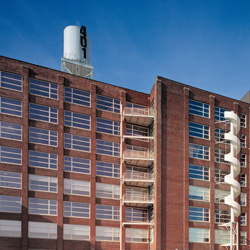
It exists in big cities like Chicago, Austin and Dallas, and mid-sized cities like Grand Rapids, Madison and Champaign. And it could exist in Peoria.
If you have read the newspaper, watched the news, or overheard a proponent like me lately, you may wonder, “What’s happening in the Warehouse District, and why is it receiving so much attention?” Let me share with you my vision—and that of a growing group—for the district’s development.
Imagine a thriving area where people enjoy a great meal, shop, work, admire artwork, exercise, watch a movie, take in a sporting event, or simply people-watch. You see families, young professionals, empty nesters, and everyone in between. Some live here and some are visiting from other parts of town and other cities—and the area benefits from this diverse cross-section. Here, people rent an apartment, own a condo or town home, or in some cases, own a single-family home with some property attached to it.
Unique to a city, this place and its scale make it comfortable for both large crowds and individuals. Its walkable design allows people to park their cars within a close distance of countless destinations. Convenience and value are defined by the experience and the close proximity of so many amenities—people want to be here for the positive energy it exudes. It’s a place where people socialize, hold community festivals and events, and bring out-of-town guests to visit; and most importantly, they love it because it contributes to their quality of life. Whether you’ve seen it or not, you can probably guess this kind of area exists in cities like Chicago, Denver, Austin and Dallas. It also exists in cities like Grand Rapids, Madison, and even closer to home, Champaign. And it could exist in Peoria.
Laying the Foundation
For years, there has been talk of redevelopment. Studies have been commissioned, and out-of-town developers have come and gone. While to many, it looks as if the Warehouse District has not changed much, great progress is being made. As a foundation for future success, Peoria has an important mix of sturdy, old buildings; vacant property for infill projects; and long-time advocates of urban development. We have had attractions like the Civic Center, Dozer Park and the promise of the riverfront for years, and more recently, we have added the Peoria Riverfront Museum, a newly renovated Pere Marquette, more good restaurants and pedestrian-friendly infrastructure.
It’s worth mentioning that the street and streetscape improvements will calm traffic, make the area more visually appealing, and give pedestrians a safe means of getting around. This progress has driven the demand for housing, which will in turn encourage other businesses to locate in the Warehouse District. These successes are important, but in many ways they remain isolated. Each element must be stitched together to create a thriving district, and that will require an understanding of the challenges and support from the community.
Shifting the Mindset
Achieving a thriving Warehouse District will, first and foremost, require a slight shift in the mindset of many Peorians. Warehouse District development is not an “either/or” proposition that would require residents to sacrifice what they already love about the city—a vibrant Warehouse District would only add to the Peoria experience. If, as a city, we can overcome the concerns about unreasonable sacrifices or drastic, negative change, we can fully address some of the other, development-specific challenges.
Development of the Warehouse District will require extra inspiration and a creative approach, to be certain. The projects that contribute to this type of development do not pass most pro formas upon first glance, and the acquisition of property can be a challenge. But at this point, the biggest challenge is finding investors who believe deeply enough in Peoria and the Warehouse District to negotiate the obstacles inherent to its development.
Engaging the Community
Dewberry believes in the Warehouse District and has taken a role in leading its redevelopment. Both as individuals and as a firm, we have been involved in master planning efforts, downtown committees, and projects like 401 Water—our office for more than 10 years. We are passionate about improving communities through design, and inspired by what Peoria could become. As designers, architects, urban planners and engineers, we’ve worked with similar communities, and we understand the elements that make them successful. We want our community to have the memorable experiences afforded by great urban development.
We’ve also conducted our own research to lower the risks, both perceived and actual, as well as catalyze further development. In doing so, we have confirmed there is strong interest in urban development, and like all adoption curves, there are radically different requirements to get people engaged. And neither last nor least, the interest in the Warehouse District comes from a diverse group of people with diverse interests. Just like impressive buildings and pedestrian-friendly infrastructure, that diversity is a key ingredient in successful urban development.
So what can we do as a community to encourage more development in the Warehouse District? Attend festivals. Eat at local restaurants. Shop at the farmers market. Catch a game. Go to a concert. Take a walk along the river. Supporting the area as it is will help draw the financial investment needed to create an even more unique, interesting and thriving district that we can all enjoy and proudly show off to family, friends and clients. iBi
Chris Waible is a designer and business development director in the Peoria office of Dewberry.

